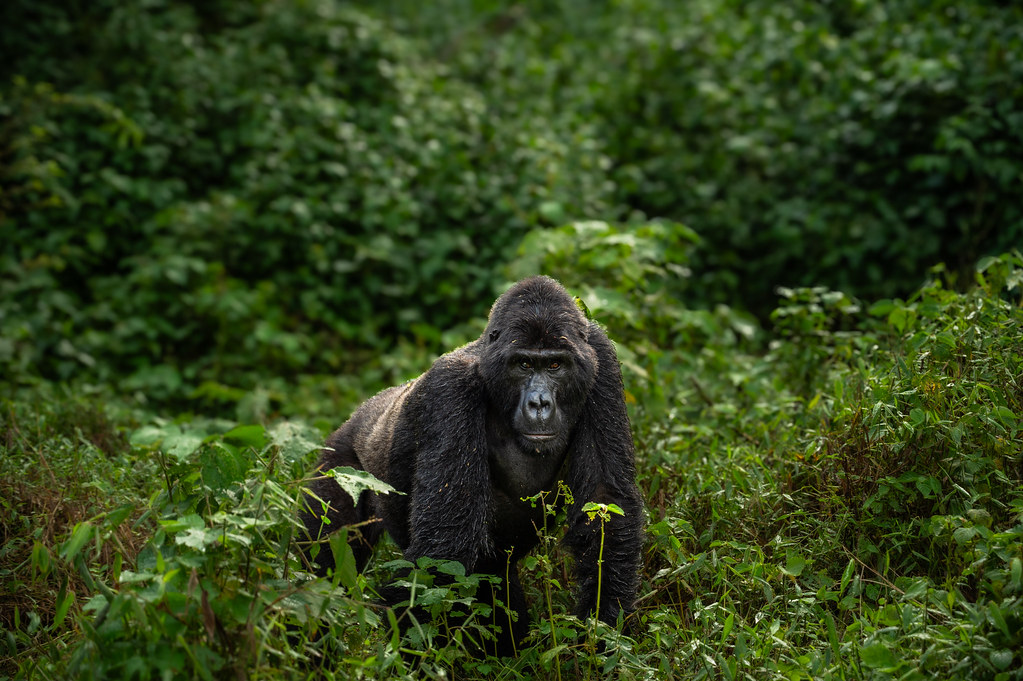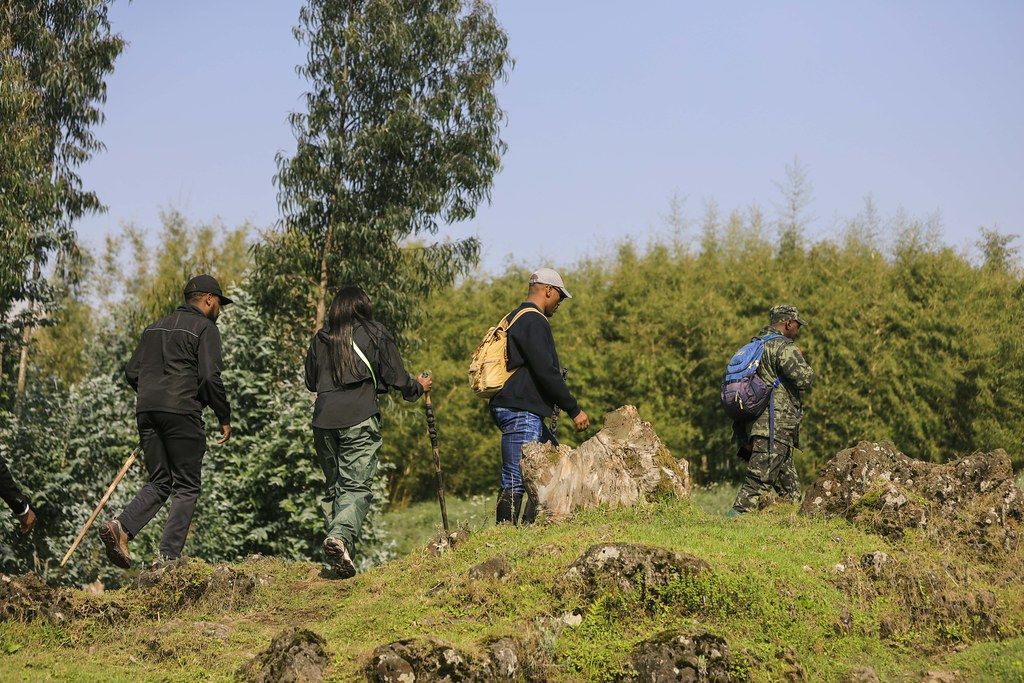How to Respond to an Approaching Gorilla – Essential Guide for Safe Gorilla Trekking
Coming face-to-face with an approaching gorilla is an extraordinary and emotional moment one filled with awe, tension, and respect for the immense power of these endangered giants. As the largest living primates, mountain gorillas inhabit the mist-covered forests of the Virunga Mountains, spanning Rwanda’s Volcanoes National Park, Uganda’s Bwindi Impenetrable and Mgahinga National Parks, and the dense jungles of the Democratic Republic of Congo’s Virunga National Park.
Their presence is commanding. Yet despite their size and muscular build, mountain gorillas are known more for their peaceful social bonds than their aggression. They live in cohesive family units led by a dominant male, the silverback who is not only the protector but also the guide of the troop’s daily life. Still, under certain circumstances, a gorilla may feel threatened enough to charge. Understanding what to do in the face of an approaching gorilla is not only crucial for your own safety, but also a sign of respect for the gorilla’s territory.
Explore some of our gorilla trekking safari packages that present the opportunity to encounter an approaching gorilla.
- 1 Day Rwanda Gorilla Tour
- 2 Days Uganda Gorilla Tour
- 5 Days Rwanda Gorilla Safari
- 4 Days Luxury Uganda Gorilla Trekking Safari
- 6 Days Luxury Gorilla Trekking Rwanda

Why an Approaching Gorilla Might Charge
In most cases, an approaching gorilla is not looking for a fight. Charges are usually bluffs designed to assert dominance or to warn intruders that they are getting too close. Mountain gorillas, especially the vigilant silverbacks, communicate their intentions long before a physical confrontation. A gorilla may grunt deeply, slap the ground, tear at surrounding vegetation, rise to its full height, or beat its chest with incredible force.
These are not random displays of aggression, but rather ritualized warnings. If a visitor, knowingly or unknowingly, violates the gorilla’s personal space, ignores these signals, or moves too suddenly, the gorilla may close the distance. A charge, though loud and intimidating, often stops short of actual contact. But not always and that’s why preparation and calm behavior are essential.
How to Respond to an Approaching Gorilla in the Wild
When you’re on foot in the forest and you witness an approaching gorilla, especially during a gorilla trek, the most important thing is to remain still. Running is a natural instinct, but it’s the worst possible reaction. Gorillas are much faster than humans, and running only triggers their instinct to chase. Instead, stay grounded both physically and emotionally. Take slow breaths and allow the gorilla to read your non-threatening presence.
It is also wise to avoid direct eye contact. In gorilla language, prolonged eye contact is a sign of confrontation. Looking to the side or at the ground signals submission and calm. Speaking softly or making no sound at all keeps the atmosphere neutral. Sudden gestures, such as raising your arms or pointing, can be misinterpreted and escalate the encounter.
There are rare cases where an approaching gorilla may come close enough to touch you or grab your hand. If this happens, the best response is to mimic behaviors they understand as peaceful. Many experienced trackers recommend staying relaxed and, if possible, gently grooming the gorilla’s hand—an action that signals trust and familiarity in gorilla society.
You might also find safety in mimicking calm, submissive behaviors. Squatting low, crouching slightly, and pretending to chew on leaves or stems can send a message that you’re no threat, merely another peaceful presence in the forest.
How Trekking Rules Help You Avoid an Approaching Gorilla
The best way to prevent an intense encounter with an approaching gorilla is to follow the rules set out in the gorilla trekking briefing. These briefings are mandatory and offered before every trek, covering essential behavior and body language. They are led by local rangers and trackers who deeply understand gorilla psychology.
Maintaining a respectful distance at least seven meters is a cornerstone of these guidelines. Talking in hushed tones, moving slowly through the underbrush, and allowing the gorillas to move freely within their habitat are all key. If your group unknowingly provokes a response from the gorilla, the guide may end the visit early. This protects both visitors and the gorillas, especially in high-stress moments.
What to Expect When Trekking Near a Gorilla Habitat
When trekking in mountain gorilla territory, you’re stepping into their world. These creatures live in high-altitude tropical forests, where terrain is steep, damp, and often slippery. To navigate it comfortably, you’ll want to dress accordingly: waterproof boots, long pants, and layers suited for fluctuating temperatures. Gloves help protect your hands as you navigate through vines and thick vegetation, and a good rain jacket is essential. Porters, available at a modest fee, can assist with bags and gear while supporting local families.
Sunscreen, insect repellent, high-energy snacks, and drinking water will keep you protected and nourished during the trek. While the experience is physically demanding, the reward of locking eyes—even momentarily—with a wild mountain gorilla is nothing short of life-changing.
Booking Permits for Gorilla Trekking in advance
Access to mountain gorillas is carefully controlled through a permit system. These permits help manage visitor numbers and fund critical conservation efforts. Since an approaching gorilla encounter is one of the most sought-after wildlife experiences in the world, securing your permit well in advance is non-negotiable. Whether you’re trekking in Uganda, Rwanda, or Congo, permits often sell out months ahead—especially during peak dry seasons.
Booking through a registered tour operator or directly via the respective country’s wildlife authority is the most reliable way to secure your trek. Your guide will not only lead the hike but also serve as your translator in the language of the forest—helping you understand when the gorillas are calm, curious, or when you’re too close for comfort.
Meeting an approaching gorilla in the wild is a powerful moment of connection between human and primate. It’s a moment that asks for humility, awareness, and deep respect for a species so closely related to our own. Though mountain gorillas are strong and formidable, they are not monsters—they are guardians of ancient forests and symbols of resilience. With proper guidance, calm presence, and an understanding of their behavior, you can safely share a space with them, even if one decides to come closer than expected.


